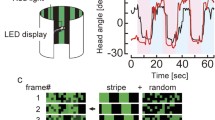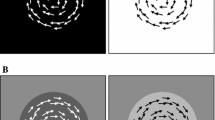Abstract
We studied temporal response properties of the H1 neuron by extracellular recording. This neuron is a wide-field movement-sensitive element in the visual system of the blowfly (Calliphora erythrocephala). If the neuron is stimulated with a stepwise pattern displacement in its preferred direction, it responds with a burst of action potentials. By repeating the stimulus step one obtains the average of the step response: a 20ms latency time followed by a sharp increase in average firing rate and a slower decay to the resting activity.
We report that the characteristic decay time of the step response depends on the stimulus history. If the stimulus moved prior to the step, the higher the pattern velocity, the faster was the decay of the step response to the resting level. In quantitative terms, for velocities in the range 0.4–100°/s, the decay time-constant varies from 300–10ms and is smaller for higher velocities. The time-constant is only weakly affected by other stimulus parameters such as modulation depth or spatial wavelength, and is set independently in different areas of the visual field where it is tuned to the local velocity.
We discuss a possible advantage of this form of adaptation for the processing of visual signals: The performance of the nolinear operations that extract information from the visual input can be optimized by prefiltering signals in the individual visual columns with a time-constant that decreases with stimulus velocity. It will be shown that both the test step response and the response to continuous movement can be described reasonably well by a correlation model with input filters that adapt their time-constants.
Similar content being viewed by others
References
Bishop LG, Keehn DG (1966) Two types of motion sensitive neurons in the fly optic lobe. Nature 212:1374–1376
Bishop LG, Keehn DG, McCann GD (1968) Motion detection by interneurons of optic lobes and brain of the flies Calliphora phaenicia and Musca domestica. J Neurophysiol 31:509–525
Buchner E (1984) Behavioural analysis of spatial vision in insects. In: Ali MA (ed) Photoreception and vision in invertebrates. Plenum Press, New York London, pp 561–622
Eckert H (1980) Functional properties of the H1 neurone in the third optic ganglion of the blowfly Phaenicia. J Comp Physiol 135:29–39
Eckert H (1981) The horizontal cells in the lobula plate of the blowfly Phaenicia sericata. J Comp Physiol 143:511–526
Götz KG (1965) Die optische Übertragungseigenschaften der Komplexaugen von Drosophila. Kybernetik 2:215–221
Hateren JH van (1981) Internal report (in Dutch)
Hausen K (1976) Funktion, Struktur und Konnektivität bewegungsempfindlicher Interneurone in der Lobula-Platte von Dipteren. Verh Dtsch Zool Ges 1976:254
Hausen K (1981) Monocular and binocular computation of motion in the lobula plate of the fly. Verh Dtsch Zool Ges 1981:49–70
Hausen K (1982a) Motion sensitive interneurons in the optomotor system of the fly. I. The horizontal cells: structure and signals. Biol Cybern 45:143–156
Hausen K (1982b) Motion sensitive interneurons in the optomotor system of the fly. II. The horizontal cells: receptive field organization and response characteristics. Biol Cybern 46:67–79
Hausen K (1984) The lobula-complex of the fly: structure, function, and significance in visual behaviour. In: Ali MA (ed) Photoreception and vision in invertebrates. Plenum Press, New York London, pp 623–559
Hausen K, Wehrhahn C (1983) Microsurgical lesion of horizontal cells changes optomotor yaw responses in the blow-fly Calliphora erythrocephala. Proc R Soc London Ser B 219:211–216
Hengstenberg R (1982) Common visual response properties of giant vertical cells in the lobula plate of the blowfly Calliphora. J Comp Physiol 149:179–193
Hengstenberg R, Hausen K, Hengstenberg B (1982) The number and structure of giant vertical (VS) cells in the lobula plate of the blowfly Calliphora erythrocephala. J. Comp Physiol 149:163–177
Lenting BPM, Mastebroek HAK, Zaagman WHZ (1984) Saturation in a wide-field, directionally selective movement detection system in fly vision. Vision Res 24:1341–1347
Leutscher-Hazelhoff JT, Barneveld HH van (1983) The Calliphora pupil and phototransduction modelling. Rev Can Biol Exptl 42:263–270
Limb JO, Murphy JA (1975) Estimating the volocity of moving objects in television signals. Comp Graph Image Process 4:311–327
Mastebroek HAK, Zaagman WHZ, Lenting BPM (1980) Movement detection: performance of a wide-field element in the visual system of the blowfly. Vision Res 20:467–474
McCann GD, Foster SF (1971) Binocular interactions of motion detection fibers in the optic lobes of flies. Kybernetik 8:193–203
Pierantoni R (1976) A look into the cock-pit of the fly. The architecture of the lobular plate. Cell Tissue Res 171:101–122
Poggio T, Reichardt W (1976) Visual control of orientation behaviour in the fly. Part II. Towards the underlying neural interactions. Q Rev Biophys 9:377–438
Reichardt W (1957) Autokorrelations-Auswertung als Funktionsprinzip des Zentralnervensystems. Z Naturforsch 12b:448–457
Reichardt W, Poggio T (1976) Visual control of orientation behaviour in the fly. Part I. A quantitative analysis. Q Rev Biophys 9:311–375
Smakman JGJ, Hateren JH van, Stavenga DG (1984) Angular sensitivity of blowfly photoreceptors: intracellular measurements and wave-optical predictions. J Comp Physiol 155A:239–247
Srinivasan MV, Dvorak DR (1980) Spatial processing of visual information in the movement-detecting pathway of the fly. J Comp Physiol 140:1–23
Strausfeld NJ (1976) Atlas of an insect brain. Springer, Berlin Heidelberg New York
Ullman S (1981) Analysis of visual motion by biological and computer systems. Computer 14:57–69
Zaagman WHZ (1977) some characteristics of the neural activity of directionally selective movement detectors in the visual system of the blowfly. Thesis, Groningen University
Zaagman WHZ, Mastebroek HAK, Buyse T, Kuiper JW (1977) Receptive field characteristics of a directionally selective movement detector in the visual system of the blowfly. J Comp Physiol 116:39–50
Zaagman WHZ, Mastebroek HAK, Kuiper JW (1978) On the correlation model: performance of a movement-detecting neural element in the fly visual system. Biol Cybern 31:163–168
Zaagman WH, Mastebroek HAK, Ruyter van Steveninck R de (1983) Adaptive strategies in fly vision: on their imageprocessing qualities. IEEE Trans Syst Man Cybern SMC 13:900–906
Author information
Authors and Affiliations
Rights and permissions
About this article
Cite this article
de Ruyter van Steveninck, R.R., Zaagman, W.H. & Mastebroek, H.A.K. Adaptation of transient responses of a movement-sensitive neuron in the visual system of the blowfly Calliphora erythrocephala . Biol. Cybern. 54, 223–236 (1986). https://doi.org/10.1007/BF00318418
Received:
Issue Date:
DOI: https://doi.org/10.1007/BF00318418




